Your kitchen is more than just a room for preparing meals; it’s the heart of your home, a gathering place for family and friends, and a hub of daily activity. With all this buzz, it’s no surprise that kitchen flooring plays a vital role in aesthetics and functionality. The right choice can elevate the design, withstand the rigors of spills and foot traffic, and make your cooking haven a truly inviting space.
In this guide, we’ll dive into selecting the perfect kitchen flooring. Whether you’re embarking on a complete kitchen renovation or considering a flooring upgrade, we’ll help you navigate the vast array of options and make an informed decision. From timeless hardwood to versatile tiles and budget-friendly vinyl, we’ll explore the pros and cons of each option, empowering you to choose a floor that suits your style and meets the unique demands of your culinary kingdom.
Let’s embark on your kitchen flooring journey so you can turn your kitchen into a space that’s as beautiful as it is practical.
1. Factors to Consider When Buying Kitchen Flooring
Choosing the right flooring for your kitchen is a significant decision that involves several crucial factors. The ideal kitchen floor should match your design preferences and stand up to the daily wear and tear of a busy culinary space. Here are the key factors you should consider:
Kitchen Flooring Durability
- One of the foremost considerations when selecting kitchen flooring is durability. Your kitchen experiences constant activity, from meal preparation to family gatherings. Choosing a flooring material that can withstand heavy foot traffic, spills, and dropped items that are part and parcel of kitchen life is essential.
- Hardwood and tile are popular options known for their durability. However, wood hardness and tile quality can influence how well they resist wear and tear.
Kitchen Flooring Maintenance
- Kitchens are prone to spills, splatters, and the occasional culinary mishap. Flooring should be easy to clean and maintain, ensuring that it continues to look its best with minimal effort.
- Vinyl and laminate flooring are known for their low maintenance requirements. On the other hand, hardwood may require regular sealing, while grout lines in tile floors may need occasional cleaning and resealing.
Style and Aesthetics
- Your kitchen’s flooring contributes significantly to the overall design and atmosphere of the space. It should harmonize with the kitchen’s style and color scheme.
- Consider whether you want hardwood’s warmth and natural beauty, the sleek versatility of tile, or the budget-friendly, stylish options offered by vinyl and laminate. The right choice can enhance your kitchen’s visual appeal.
Kitchen Flooring Budget Considerations
- The cost of flooring materials can vary widely. Establishing a budget that aligns with your financial constraints and renovation plans is crucial.
- Hardwood tends to be on the higher cost spectrum, while options like vinyl and laminate are more budget-friendly without sacrificing aesthetics.
Balancing these factors is critical to making a well-informed decision. Your choice should reflect your kitchen’s specific needs and your personal preferences. In the following sections, we’ll delve into various flooring options, exploring the advantages and disadvantages of each to help you make a choice that’s perfect for your kitchen.
Kitchen Flooring Options
Now that we’ve covered the essential factors to consider when choosing kitchen flooring let’s explore the vast array of options available. Each type of flooring brings its unique characteristics and advantages to the table. Here’s an overview of the most common kitchen flooring options:
Hardwood Kitchen Flooring
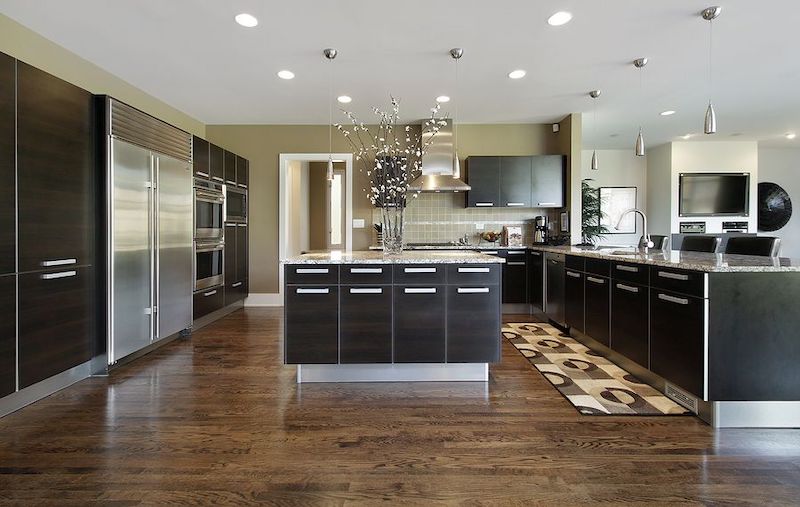
Pros:
- Timeless beauty: Hardwood flooring exudes warmth and elegance, providing a classic look that never goes out of style.
- Durability: High-quality hardwood can withstand the challenges of the kitchen if correctly cared for and maintained.
- Increased home value: Hardwood is often seen as an attractive feature in homes, which can add to your property’s value.
Cons:
- Vulnerable to moisture: Hardwood flooring is sensitive to moisture and spills, making it necessary to clean up quickly.
- Scratches and dents: Hardwood flooring can develop scratches and dents over time despite its durability.
Tile Kitchen Flooring
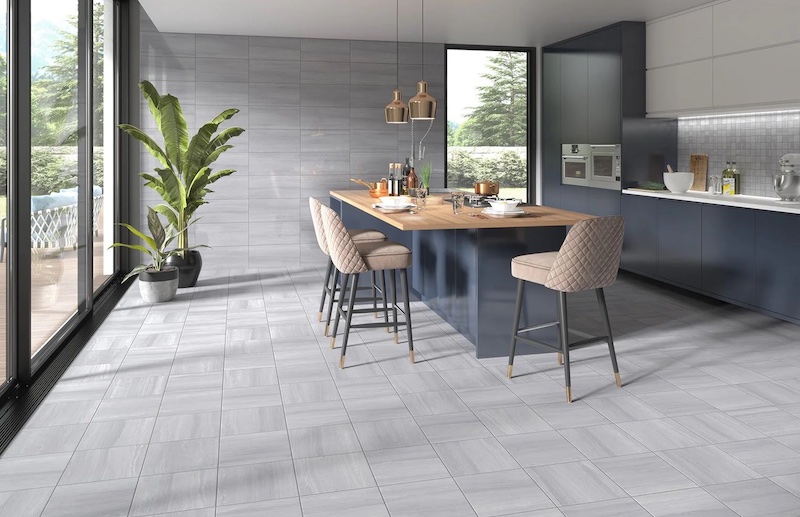
Pros
- Variety: Kitchen tile flooring come in various materials, sizes, and colors, allowing for versatile design options.
- Durability: Ceramic and porcelain tiles are highly durable, resistant to moisture, and easy to clean.
- Low maintenance: Tiles are virtually maintenance-free, with regular cleaning keeping them in top condition.
Cons
- Cold and hard: Tiles can be cold underfoot and less forgiving if you drop delicate items.
- Grout lines: They can stain over time and require maintenance to keep them looking clean.
Luxury Vinyl Kitchen Flooring
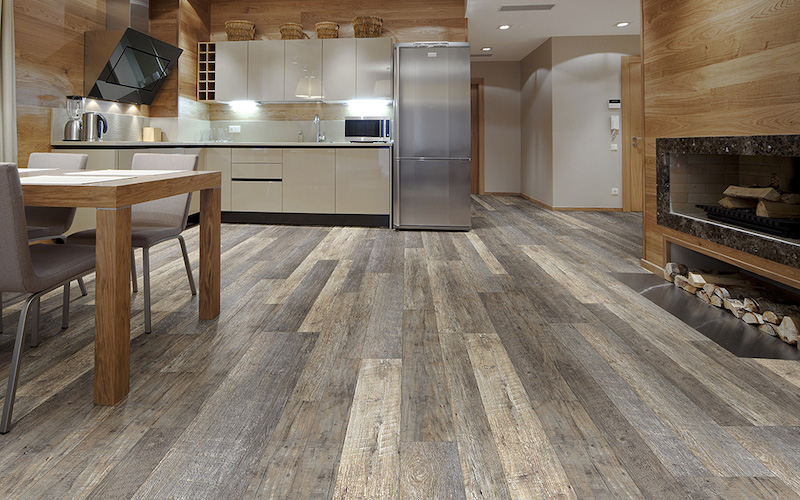
Pros:
- Affordability: Vinyl is a budget-friendly flooring option, making it accessible to many homeowners.
- Resilience: Luxury vinyl flooring is highly resistant to water and spills, making it suitable for kitchens.
- Wide design range: Vinyl comes in an extensive range of designs, including wood and stone looks.
Cons:
- Vulnerable to sharp objects: Sharp objects can potentially damage vinyl flooring.
- Not as luxurious: While it offers practicality, vinyl may lack the upscale appearance of hardwood or natural stone.
Luxury Laminate Kitchen Flooring
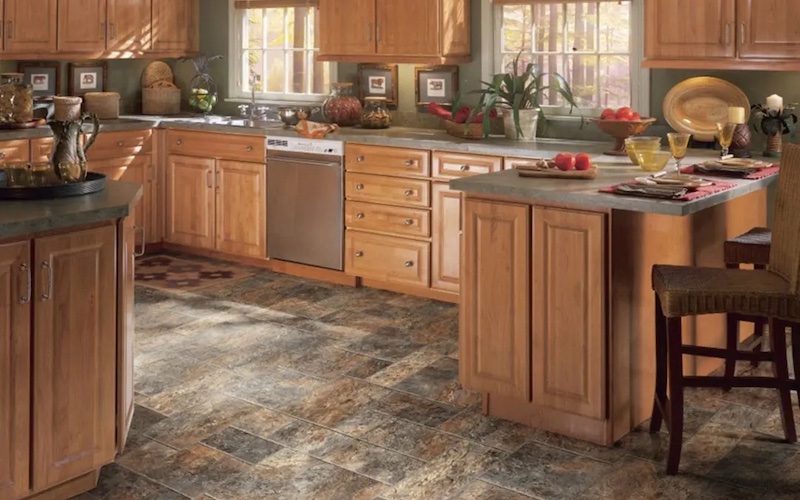
Pros:
- Affordability: Laminate is another budget-friendly choice that can mimic the look of hardwood or tile.
- Durability: It’s known for its scratch and dent resistance, making it suitable for busy kitchens.
- Easy installation: Many luxury laminate flooring options feature a click-and-lock system for straightforward installation.
Cons:
- Moisture sensitivity: Laminate is not as water-resistant as other options, so cleaning spills promptly is crucial.
- Limited refinishing: Unlike hardwood, laminate cannot be sanded and refinished if it gets damaged.
Cork Flooring
Pros:
- Eco-friendly: Cork is a sustainable material harvested from cork oak trees.
- Comfort underfoot: Cork provides a soft, cushioned surface that’s easier on the legs and feet.
- Sound insulation: It can reduce noise, making it an excellent choice for busy kitchens.
Cons:
- Vulnerable to moisture: Cork can be damaged by excess moisture if not sealed properly.
- Prone to scratches: Sharp objects can leave marks on cork flooring.
Linoleum Flooring
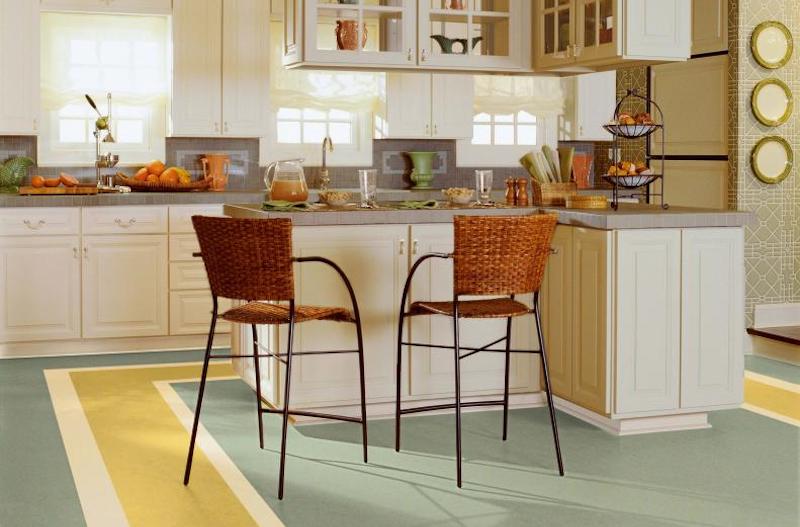
Pros:
- Natural and eco-friendly: Linoleum is made from raw materials like linseed oil, making it eco-friendly.
- Durable: It can withstand the rigors of the kitchen and is resistant to stains and water.
- Wide color range: Linoleum is available in various colors and patterns.
Cons:
- Initial odor: Linoleum may have a natural odor when first installed but dissipates over time.
- Professional installation: It’s often recommended to have linoleum professionally installed.
Concrete Flooring
Pros:
- Modern and industrial appeal: Concrete provides a sleek, contemporary look with minimal maintenance.
- Durability: It’s highly resistant to moisture and wear, making it suitable for kitchens.
Cons:
- Cold and hard surface: Concrete can be cold and hard underfoot, which may not be comfortable for extended periods.
- Can crack: Over time, concrete may develop cracks or imperfections.
Each of these flooring options offers unique advantages and disadvantages, making the decision a balance between your personal preferences and the specific needs of your kitchen. In the following sections, we’ll delve deeper into each flooring type, helping you make a more informed choice for your culinary space.
Trends and Styles
Kitchen flooring trends evolve, reflecting changing design preferences and technological advancements. Staying up-to-date with these trends can help you make a flooring choice that serves your kitchen’s functional needs and keeps your space looking fresh and stylish. Here are some of the current trends and styles in kitchen flooring:
Mixing Materials:
A trend gaining popularity is the art of mixing flooring materials. This allows you to create defined zones within your kitchen. For example, hardwood flooring can seamlessly transition to tile, delineating cooking and dining areas. The visual contrast adds depth and character to your kitchen’s design.
Patterned Tiles:
Patterned tiles, whether encaustic, geometric, or intricately designed, are making a comeback. These tiles inject personality and vibrancy into your kitchen. They work exceptionally well as a focal point, such as a decorative backsplash or a defined area under an island.
Sustainable and Eco-Friendly Choices:
Sustainability is more than a trend; it’s a lifestyle choice. Many homeowners opt for environmentally friendly flooring materials such as bamboo, cork, and reclaimed wood. These options reduce your carbon footprint and introduce natural warmth and charm to your kitchen.
Light vs. Dark Contrasts:
A perennial debate in kitchen design is choosing light or dark flooring. Light-colored floors can create a sense of spaciousness and brightness, making small kitchens appear more prominent. On the other hand, dark floors can introduce dramatic contrasts and cozy atmospheres. Your choice depends on the look and ambiance you desire for your kitchen.
Staying informed about these trends can help you align your kitchen’s flooring with your style and design preferences. Remember, trends can serve as inspiration, but selecting a flooring option that harmonizes with your kitchen’s aesthetics and meets your practical requirements is essential. In the following sections, we’ll delve deeper into the practical considerations of each flooring type to help you make an informed decision.
Practical Tips
Selecting the right kitchen flooring is a substantial decision. To ensure that your choice aligns with your kitchen’s functionality and style, consider these practical tips:
Take Samples Home:
Before making a final decision, obtain samples of your preferred flooring options. Viewing them in your kitchen’s lighting and alongside your existing decor can help you visualize how they’ll look in your space. It’s essential to consider factors like how the flooring complements your cabinets, countertops, and wall colors.
Professional Installation:
While some flooring materials can be installed as a DIY project, relying on professional installers is often wise, especially for materials like hardwood and tile. Professional installation ensures a secure, long-lasting result and reduces the likelihood of issues.
Maintenance and Cleaning:
Different flooring types require various maintenance routines. Be aware of the specific care your chosen flooring demands. For instance, hardwood floors may need regular resealing, while tile grout requires occasional cleaning and resealing. Vinyl and laminate are low-maintenance options.
Non-Slip Considerations:
Safety in the kitchen is paramount. Consider the slip resistance of your chosen flooring material, especially in areas where spills are more likely, such as around the sink or dishwasher. Look for flooring options with anti-slip features, or add non-slip rugs and mats in strategic places.
Harmonize with Cabinets and Countertops:
Your flooring should complement your kitchen cabinets and countertops. Coordinate the colors, textures, and styles to create a balanced look. For example, light-colored flooring can make an appealing contrast if you have dark cabinets.
Sample Spills and Clean-Up:
Before finalizing your choice, simulate common kitchen accidents with your sample pieces. Spill some water, juice, or other liquids on the samples and test how easy they are to clean. This will give you a real-world understanding of how well your chosen flooring can handle mishaps.
Future Refinishing and Repair:
Consider the long-term prospects of your flooring. Hardwood can be refinished, but if you opt for an option like laminate, be aware that damaged sections may require replacement rather than refinishing.
By heeding these practical tips, you can make an informed decision when choosing your kitchen flooring. A well-considered choice will enhance your kitchen’s aesthetics and provide the durability and functionality necessary for your busy culinary space. In the following sections, we’ll delve deeper into each flooring type’s specific features and maintenance requirements.
Conclusion
Your kitchen is more than just a room for cooking; it’s the heart of your home, where cherished memories are created and the hub of daily activity. As we’ve journeyed through the intricate process of selecting the right flooring for your kitchen, you’ve gained insights into the factors that play a pivotal role in making an informed decision.
The ideal kitchen flooring is durable and easy to maintain and complements your kitchen’s aesthetics, enhancing its overall appeal. It’s a choice that impacts your culinary space’s functionality and style. So, whether you dream of the timeless elegance of hardwood, the versatility of tile, or the cork’s eco-friendliness, your decision reflects your unique needs and personal style.
Remember, trends can provide inspiration, and practical tips can guide your choices, but your space, lifestyle, and preferences should ultimately drive your selection. Take your time, explore your options, and find the flooring that not only meets the demands of your kitchen but also celebrates the beauty of your culinary haven.
Happy cooking and happy living!
Additional Resources:
We hope this guide has provided valuable insights into choosing the right flooring for your kitchen. If you’re looking for more information and resources on kitchen renovation and design, here are some additional sources you might find helpful:
1. National Kitchen and Bath Association (NKBA): The NKBA offers a wealth of information on kitchen and bathroom design, including inspiration galleries, design trends, and certified professionals in your area.
2. Home Design Magazines: Magazines like Better Homes & Gardens and Architectural Digest often feature articles on kitchen design, including flooring trends and inspiration.
3. National Wood Flooring Association (NWFA): If you’re considering hardwood flooring, the NWFA offers resources on wood flooring types, installation, and care.
4. Tile Council of North America (TCNA): For tile flooring enthusiasts, TCNA provides valuable information on tile selection, installation, and maintenance.
5. Online Forums and Communities: Join online home improvement forums and communities, such as Houzz, Reddit’s r/HomeImprovement. Reddit allow yous to ask questions, share experiences, and gain insights from fellow homeowners and experts.
6. Interior Design Books: Visit your local library or bookstore for interior design and kitchen renovation books. These resources can provide in-depth information on flooring and design principles.
Remember that the right flooring choice for your kitchen should reflect your unique needs and preferences. Explore these resources to further enhance your knowledge and design inspiration as you embark on your kitchen renovation journey.

Recent Comments